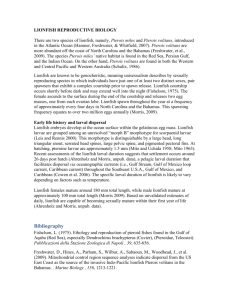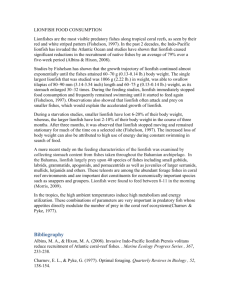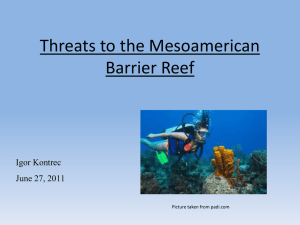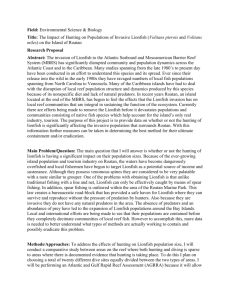(Pterois volitans) larvae to temperature variations
advertisement
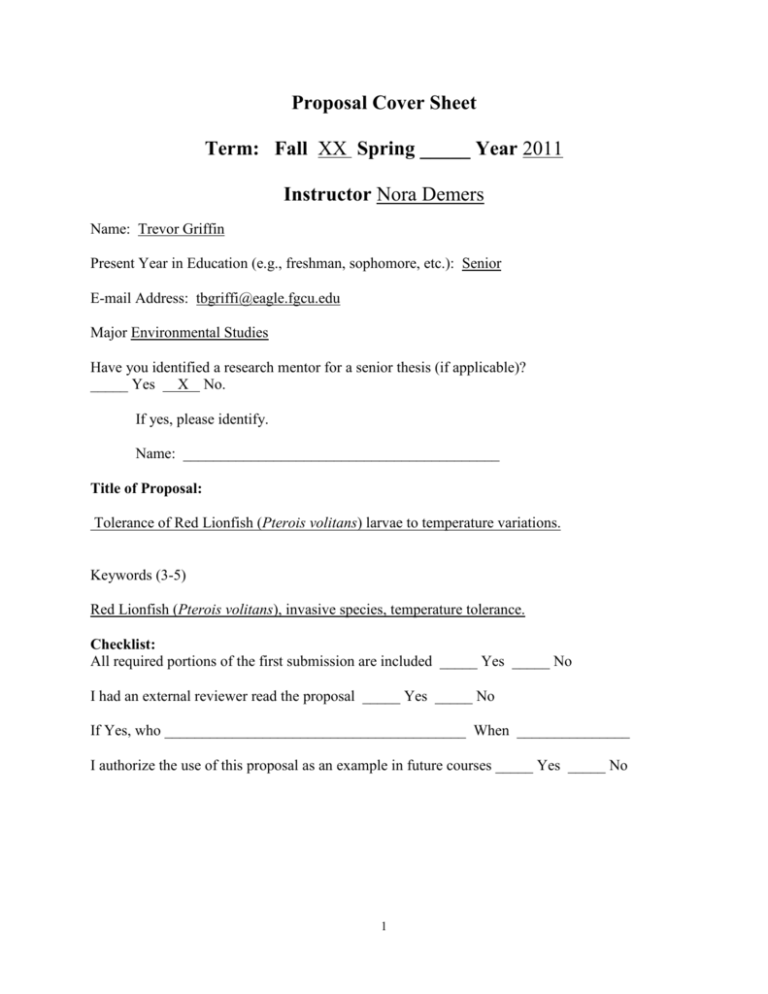
Proposal Cover Sheet Term: Fall XX Spring _____ Year 2011 Instructor Nora Demers Name: Trevor Griffin Present Year in Education (e.g., freshman, sophomore, etc.): Senior E-mail Address: tbgriffi@eagle.fgcu.edu Major Environmental Studies Have you identified a research mentor for a senior thesis (if applicable)? _____ Yes X No. If yes, please identify. Name: __________________________________________ Title of Proposal: Tolerance of Red Lionfish (Pterois volitans) larvae to temperature variations. Keywords (3-5) Red Lionfish (Pterois volitans), invasive species, temperature tolerance. Checklist: All required portions of the first submission are included _____ Yes _____ No I had an external reviewer read the proposal _____ Yes _____ No If Yes, who ________________________________________ When _______________ I authorize the use of this proposal as an example in future courses _____ Yes _____ No 1 Trevor Griffin Scientific Process Professor Demers 10-18-11 Tolerance of Red Lionfish (Pterois volitans) larvae to temperature variations. 2 Summary The Red Lionfish is venomous, predatory species native to the Indo-Pacific. They have been released into the Western Atlantic through the aquarium trade, and pose potential threats to native reefs by reducing recruitment and biodiversity (Albins 2008). Little is known about lionfish, particularly lionfish larvae; so effective management practices have yet to be developed. One of the things known about lionfish is that they spawn year around and that their gelatinous egg masses facilitate planktonic dispersal (Betancur et al. 2011). This means that the larvae could end up anywhere. This study will look at the temperature tolerances of Red Lionfish larvae, as a way of estimating the potential range of the Red Lionfish in the Western Atlantic. This will be achieved by collecting samples of Lionfish larvae from the southeast coast of Florida, and placing them in tanks at Florida Gulf Coast University. These lionfish larvae will then be subjected to different temperature changes until they have a loss of equilibrium, indicating lack to tolerance to that temperature. 3 Table of Contents I. Project Description A. Introduction......................................................................5 B. Research Objectives……………………………………………………..6 C. Methods……………………………………………………………………6-7 a. Study Design…………………………………………………6-7 b. Data Collection……………………………………………….7 c. Data Analysis………………………………………………….7 II. References Cited…………………………………………………………….8 III. Curriculum Vitae……………………………………………………….9-11 4 Introduction Lionfish are a venomous, predatory species native to the Indo-Pacific. They are found between 0-50 meters in their native waters (Fishelson 1975). Red Lionfish are a popular ornamental fish that were introduced into the Western Atlantic in the late 1980s and1990s through aquarium releases (Betancur et al. 2011). They are the first non-native marine fishes to be established in the Western Atlantic (Schofield 2009). Lion fish abundance has increased in the Western Atlantic due to their lack of natural predators. Non-native Red Lionfish pose potential threats to reefs by reducing recruitment and biodiversity (Albins 2008). There is very little known about the biology and ecology of lionfish in their native habitat let alone as an invasive species (Morris 2008). One of the things that is known is that lionfish spawn year-around and their gelatinous egg masses facilitate planktonic dispersal (Betancur et al. 2011). There have been previous studies on adult lionfish that indicate that they have a mean chronic lethal minimum temperature of 10C and they cease feeding at 16C (Kimball 2004). Although there is some knowledge of adult lionfish tolerances, there is little known about the tolerances of the larvae of this species. The purpose of my study is to determine the thermal tolerances of larval lionfish in the Western Atlantic. The information from this study can be used to assist fisheries managers in determining the potential distribution of red Lionfish in the Western Atlantic. 5 Research Objectives The planktonic dispersal of Red Lionfish larvae could allow them to spread much further than if they had to swim. Little is known about the tolerances of lionfish larvae, so this study will examine the extreme temperature (cold and hot) tolerances of lionfish larvae. The purpose of this study is to examine the potential spread of the Red Lionfish (Pterois volitans) in the Atlantic Ocean off the east coast of the United States. Methods A. Study Design Forty lionfish larvae will be collected from patch reefs at various water depths off the east coast of South Florida, to insure genetic variation. Larvae will be collected in the months of May through August. These specimens will be kept in a live well, which will provide fresh water on a regular basis during transport from collection sites to the laboratory. The larvae will be kept in several tanks in a Florida Gulf Coast University laboratory for the duration of the study. The specimens will be held in the laboratory for a minimum of thirty-six hours after transport to allow for stress levels to lower and any lionfish that were damaged from transport to be removed from the testing group. During testing the lionfish larvae will be placed a 30 gallon tank, five at a time. They will be allowed to acclimate to the water, which will be held at a constant temperature of 25oC. For the high temperature study the water temperature will be raised 0.2oC every minute until there is a loss of equilibrium. The low temperature study will be the exact opposite; 6 the water temperature will be lowered 0.2oC every minute until there is a loss of equilibrium. These studies will be done with two different groups of lionfish as not to over stress one group. Both the high and low temperature studies will be done on twenty to twenty-five fish each to obtain accuracy. After the test the lionfish will be placed in a separate tank to prevent them from being used in one of the other test. B. Data Collection Lionfish will be randomly selected for each test and placed in a fifty-five gallon tank and acclimated for a minimum of twenty-four hours, they will also not be fed during this time. As the temperature is raised or lowered: the temperature, color changes in fish, and behavior will be recorded every minute. Dissolved oxygen levels will also be recorded every five minutes to exclude loss of oxygen as reason for loss of equilibrium. C. Data Analysis The mean temperatures that loss of equilibrium occurred will be calculated, from all parts of each test. These will then be placed in graph form to compare overall extreme high and low temperatures that the larval lionfish lost equilibrium. 7 References cited Albins, Mark A; Hixon, Mark A (2008). Invasive Indo-Pacific lionfish Pterois volitans reduce recruitment of Atlanic coral-reef fishes. Marine Ecology Progress Series, 367, 233-238. Betancur-R, Ricardo; Hines, Andrews; Acero P, Arturo; Orti, Guillermo; Wilber, Ami, E; Freshwater, DWilson(2011). Reconstructing the lionfish invasion: insights into Greater Caribbean biogeography. Journal of Biogeography, 38, 1281-1293. Fishelson, L. (1975). Ethology and reproduction of pteroid fishes found in the Gulf of Aqaba (Red Sea), especially Dendrochirus brachypterus. Pubbl. Staz. Zool. Napoli. 39, 635-656. James A. Morris, Jr., J.L. Akins, A. Barse, D. Cerino, D.W. Freshwater, S.J. Green, R.C. Munoz, C. Paris, P.E. Whitfeild (2008). Biology and Ecology of the Invasive Lionfishes, Pterois miles and Pterois volitans. Proceedings of the 61st Gulf and Caribbean Fisheries Institute. Kimball, ME; Miller, JM; Whitfield, PE; Hare, JA (2004). Thermal tolerance and potential distribution of invasive lionfish (Pterois volitans/miles complex) on the east coast of the United States. Marine Ecology Progress Series, 283, 269-278. Pamela J. Schofield (2009). Geographic extent and chronology of the invasion of the non-native lionfish in Western North Atlantic and Caribbean Sea. Aquatic Invasions, 4 8 Curriculum Vitae Trevor B. Griffin 8394 Wren Road- Fort Myers, FL 33967 tbgriffi@eagle.fgcu.edu (561)346-6755 EDUCATION Expected Graduation August 2012 Florida Gulf Coast University, Fort Myers, FL Pursuing a Bachelor of Arts Degree in Environmental Studies with a Minor in Interdisciplinary Studies Relevant coursework: Fisheries Management, Natural Resource Management, Coastal Zone Management, Conservation Strategies for a Sustainable Future, Integrated Ecosystems Management Summer 2005 Montana State University, Bozeman, MT Relevant coursework: Ecology of the Yellowstone Ecosystem 2002-2006 Jupiter Community High School, Jupiter, FL Jupiter Environmental Research and Field Studies Academy 9 EMPLOYMENT 2008-present Estero River Outfitters- Estero, FL Ensure customer satisfaction, resolve customer problems Redesigned shop to improve marketing Guide tours of 10-30 people in kayaks around Estero Bay Represent business during offsite demonstrations Maintain public image on Facebook with weekly updates and public announcements 2005-2007 Ellison Graphics- Jupiter, Fl General labor Assisted with inventory Processed shipping/ receiving in warehouse Delivered products 2003-2008 Griffin Marine Management- Jupiter, FL Maintained yachts Repaired engines 10 SERVICE 2005-present Eagle Scout- Jupiter, FL Planned and oversaw a 10 day wilderness canoe trip with 8 scouts to Bissett, Manitoba. SCIENTIFIC VOLENTER WORK Corkscrew swamp bird survey: I, along with some bird experts, collected data about bird populations in Corkscrew Swamp Sanctuary. This is a yearly study to monitor the changing populations of both resident and migratory birds in the southeastern flyway. Florida Wildlife Conservation Commission Frog Survey: I was assigned a route that I would drive at least once a month to gather data on frog populations. I would gather this data by listening to frog calls at particular listening points along the study route. 11
